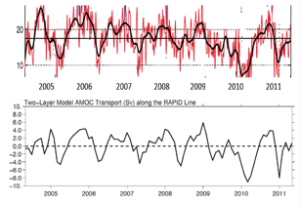By Xiao-pei Lin
“AMOC, consisting of a northward flow of warm surface waters and a southward flow of cold deep waters, is the leading mechanism for heat transport and carbon sequestration in the Atlantic Ocean,” said Macdonald and Wunsch in 1996.
As the key component of global meridional overturning circulation, Atlantic Meridional Overturning Circulation (AMOC) plays a significant role in modulating the global climate system, which has drawn continuous attention from oceanographers for decades. However, increasing knowledge on the AMOC has not clarified its nature, but led us to more confusion.
Studies on the mechanism of AMOC can date back to 1950s, when AMOC was viewed as a source/sink-driven overturning cell and often simplified as a conveyor belt for exporting the deep water formed in the high latitude of the North Atlantic to the low latitude and South Atlantic. Variability of the AMOC was supposed to be controlled by either the source, i.e., the production of deep water, or the sink, i.e., the return of deep ocean water to the surface. This simple framework has been dominating our society for decades.
However, this traditional view has been challenged lately by a number of studies. Dr. Jian Zhao, who just completed his doctorate from University of Miami, suggested seasonal cycle of AMOC, and a large part of AMOC interannual variability at 26.5°N, are controlled mainly by wind forcing. Jiayan Yang, a PI from Woods Hole Oceanographic Institution, says,“Recent work shines light on that it is the wind stress not the buoyancy flux that is the leading mechanism for AMOC variability from seasonal to interannual, even decadal time scales.”
This phenomenal idea drives us to look further into the mechanism of AMOC and answer the question, “What is the real puppet master of the AMOC variability?”. Is it thermal driven or wind driven at different time scales? By what process the wind forcing influences on the AMOC? Can the processes mentioned above be quantitatively described?

Fig 1. Top: AMOC transport time series computed from observations made by RAPID-MOCHA array (thin red line and thick black line are for 10-day and 3-month low-pass filtered data; from McCarthy et al., 2012); Bottom: model simulated AMOC transport (monthly mean) along the RAPID Line from our preliminary study.
By collaboration with Jiayan Yang from Woods Hole Oceanographic Institution and Jian Zhao from University of Miami, we developed a two-layer model which can stimulate the observed AMOC variability perfectly in subtropical area (Fig.1). Primary results from this model indicate that barotropic and first-mode baroclinic processes driven by wind forcing could dominate the variability of the AMOC in subtropical area, at least on interannual time scale.
How about the processes regulating the AMOC variability in subpolar area where buoyance-forced changes could have larger amplitude? Can wind forcing still be dominating or it finally bows to buoyancy forcing? Further studies need to be conducted to resolve these puzzles. With progresses to be achieved by the trans-basin, full-water column observation of the OSNAP, and combining the simple dynamic model with MITgcm, we look forward to quantify the wind and buoyancy forcing and figure out what is the real puppet master of the AMOC variability.